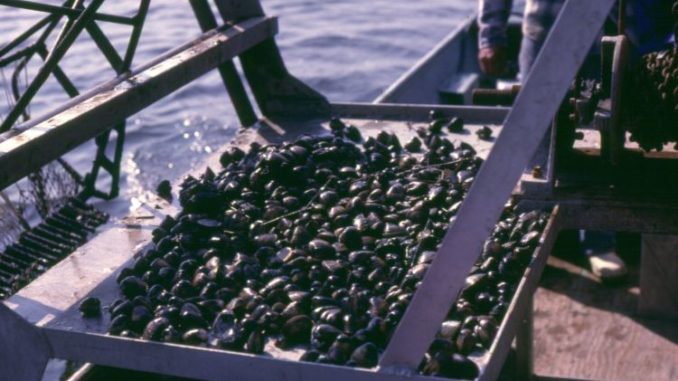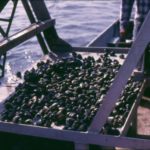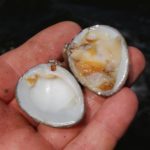
Oysters aren’t the only mollusks around
Ask the average person what the most-common mollusk is in Louisiana’s coastal marshes, and odds are strong they would answer “oysters.” Now, a lot of oysters are out there, and they are delicious.
But Louisiana probably — no proof, just an educated guess — has a lot more rangia clams than oysters. They don’t get a lot of attention because they live in the mud and don’t build fish-holding reefs, and we don’t eat them.
The clams — actually two closely related species — range from 1 to 2½ inches in size, with heavy, dense shells coated with a brown to black pigmented layer called a periostracum. Very often, chips and pieces of the periostracum flake off, revealing a white shell beneath. The inside of the shell is glossy white.
Identification is aided by rangia clams being the only clam species that occurs in low-salinity, inshore bays and lakes. Preferred salinities are 2 to 18 parts per thousand (ppt). By comparison, full-strength sea water is 35 ppt.
The two species are Rangia cuneata and Rangia flexuosa, the latter being the smaller of the two. Rangia cuneata is by far the most common of the two species and the one we will mostly discuss here.
Clam-ologists — they prefer to be called malacologists — seem to be conflicted as to the accepted proper name for Rangia cuneata. Searching in scientific literature shows the names brackish marsh clam, brackish water clam, common rangia, Atlantic rangia, estuarine clam and gulf wedge clam.
In the areas of best salinities, they seem to prefer soft, sandy mud bottoms and turbid waters. Few rangia are found in hard sand or clay bottoms and are typically found in water less than 20 feet deep, with the most clams found around 8 feet deep.
Under the best conditions, their numbers can be mind-boggling. In Lake Maurepas, rangia clam beds held 800 clams per square yard of bottom. The minimum number estimated to be alive at any time in the area between the Atchafalaya River and Sabine Lake is 24 to 48 billion.
Rangia can survive substantial periods of time of no oxygen in the water but will die quickly if removed from the water and exposed to air.
They are primarily filter feeders, straining large qualities of broken-down plant material and plankton from the water. Some nourishment is also apparently taken in by eating bacteria in the mud in which they live.
Clams in turn are eaten by many creatures. Large clams are prey for black drum, sheepshead, blue crabs and oyster drills. Smaller clams are eaten by these predators, as well as diving ducks, stingrays, gars, blue catfish, hardhead catfish, gaspergou and croakers.
Although spawning may take place year-round in Louisiana, it has been documented from March to May and again from late summer to November. Eggs and sperm are released directly into the water for random fertilization.
A fertilized egg produces two larval stages, the latter of which settles to the bottom in its permanent home. Once there, clams are not capable of any movement in the mud, except up or down.
They reach adulthood in 2 to 3 years and at about 1 inch wide. Average lifespan is 4 to 5 years, with an estimated maximum of 10 to 15.
Rangia clams were heavily used as food in Louisiana by coastal Indians. Their shell mounds — essentially garbage dumps — still exist as small islands of firm land, often crowned with live oak trees, in a surrounding sea of soft marsh.
European settlers in Louisiana made little use of them for food, finding them to have a strong, muddy taste. Elsewhere, efforts were made to can them. In 1893, the Givens Oyster Company in Texas canned them as “little neck clams.” Rangia were also canned in Cape May, New Jersey and North Carolina.
Louisiana’s one serious effort to market them as human food came in 1980s, when LSU scientists and commercial fishermen from St. Bernard Parish worked in cooperation. The clams were dredged by commercial boats and were placed in trays off of the bottom to allow them to purge themselves.
Marketed as “Cajun Clams,” they were targeted for Atlantic Coast markets as littleneck clams. They proved to have a very good taste when eaten raw. Unfortunately, cooking caused them to develop a strong, musty flavor. In spite of much university research, the problem was never solved and the infant fishery disappeared.
Both species of Rangia are eaten today at the southern end of their range, in Alvarado Lagoon in Mexico. As of 2004, a fishery involving 450 people fished for the clams by wading. They cover their fingers with small rubber balloons to protect them from cuts from the shells as they grope for them by hand in waist- deep water. They put their harvested clams in floating plastic boxes attached to their waists by a cord.
In five hours, a fisherman typically harvests 1,500 clams, weighing 130 pounds. Fishermen receive 32 to 39 cents per pound for the Atlantic rangia and somewhat less for the smaller brown rangia.
Nearly all the harvested clams are trucked to Mexico City, with smaller amounts sent to markets in and near Veracruz City. Retail prices for the Atlantic rangia in public markets are 70 cents to one dollar per pound.
In spite of their muddy taste, fishing families eat them about once a week. A traditional food preparation is “arroz a la tumbada,” a soup made with the clams and boiled rice. These soups may also contain blue crabs, shrimp, oysters, fish, or squid, as well as clams.




